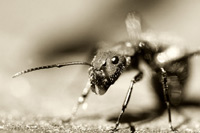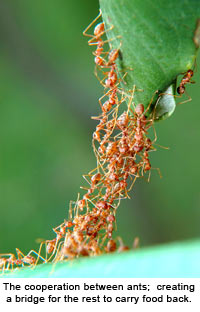|

Ants have colonized almost every landmass on Earth and can constitute
up to 15% of the total animal biomass of a tropical rainforest.
As of 2006, there are 11,880 known ant species, most of which reside
in hot climates.

They can sense with organs located on the antennae, which can detect
pheromones and hydrocarbons on the outer layer of the body. The
latter is highly important for the recognition of nestmates from
non-nestmates. Also, they communicate with sound in the form of
vibrations moving through the ground.
Most queens and male ants have wings, which they drop after the
nuptial flight; however wingless queens and males can occur.
The life of an ant starts with an egg, and the sex, female or male,
is determined by whether the egg is fertilized or not, respectively.
Ants develop by metamorphosis, passing through larval and pupal
stages before becoming adults.
A new worker spends the first few days of its adult life caring
for the queen and young. After that it graduates to digging and
other nest work, and then to foraging and defense of the nest. These
changes are fairly abrupt and define what are called temporal castes.
One theory of why this occurs is because foraging has a high death
rate, so ants only participate in it when they are older and closer
to death anyway.
Smelling antennae: Like other insects, ants smell with their antennae, which are long
and thin. These are fairly mobile, having a distinct elbow joint
after an elongated first segment, and since they come in pairs they
provide information about direction as well as intensity. Pheromones
are also exchanged as compounds mixed in with the food interchanged
in trophallaxis, giving the ants information about one another's
health and nutrition. Ants can also detect what task group (e.g.
foraging or nest maintenance) other ants belong to. Of special note,
the queen produces a special pheromone without which the workers
will begin raising new queens.
Small but tough: Ants attack and defend themselves by biting, and in many species,
stinging, in both cases sometimes injecting chemicals into the target.
 Power walkers: Ants usually lose, or never develop, their wings. Therefore, unlike
their wasp ancestors, most ants travel by walking. Some tend to
develop literal paths, the tiny equivalent of deer paths, as well
as creating unseen paths using chemical hints left for each other
to smell. Power walkers: Ants usually lose, or never develop, their wings. Therefore, unlike
their wasp ancestors, most ants travel by walking. Some tend to
develop literal paths, the tiny equivalent of deer paths, as well
as creating unseen paths using chemical hints left for each other
to smell.
Amazing cooperation: The more cooperative species of ants sometimes form chains to bridge
gaps, underground, over water, or through spaces
in arboreal paths.
Sometimes pests: Ants are useful for clearing out insect pests and aerating the
soil. On the other hand, they can become annoyances when they invade
homes, yards, gardens and fields. Carpenter ants damage wood by
hollowing it out for nesting. Nests may be destroyed by tracing
the ants' trails back to the nest, then pouring boiling water into
it to kill the queen. (Killing individual ants is less than effective
due to the secretion of pheromones mentioned above). Ordinary chalk
can be used to keep ants at bay; drawing a line or circle around
the protected area may prevent them from entering.
Some species, called killer ants, have a tendency to attack much
larger animals during foraging or in defending their nests. Human
attacks are rare, but the stings and bites can be quite painful
and in large enough numbers can be disabling.
All text is available under the terms
of the GNU Free Documentation License
|